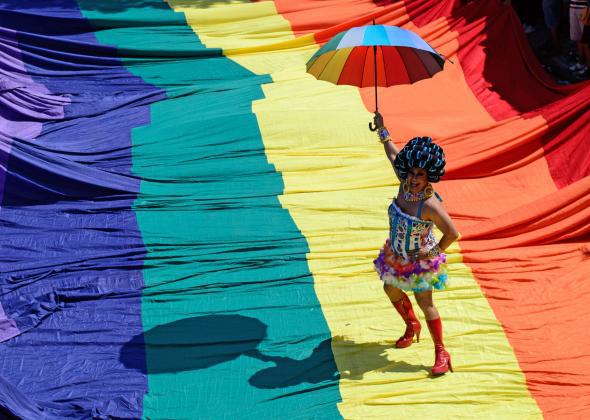When we launched Outward, my colleagues and I quickly realized that art would be a problem. Many of our posts are on general themes or issues within the LGBTQ world (as opposed to, say, specific people), and finding illustrations for themes can be hard. An easy solution, of course, was the rainbow symbol—specifically in its manifestation as a flag—and we used that for a time. But soon, our article feed was filled with rainbow flags, and we were forced to make the tough decision to ban them in all but the most desperate or particularly germane of cases.
This post is, thankfully, of that latter class! The Museum of Modern Art in New York announced on Wednesday that it has officially added the rainbow flag to its design collection, where it will join the @ sign and recycling symbol in perpetuity. While MoMA’s timing of the acquisition is clearly meant to signal its participation in June’s LGBTQ Pride festivities, it’s more than a public relations move—the story behind the creation of the rainbow flag is genuinely fascinating and worthy of preservation.
The invention of the flag is credited to Gilbert Baker, an artist who fashioned the first version in 1978 in San Francisco. In a wonderful interview conducted by MoMA, Baker shares why he felt that having a colorful symbol for the liberation movement was important: “It was necessary to have the Rainbow Flag because up until that we had the pink triangle from the Nazis—it was the symbol that they would use [to denote gay people]. It came from such a horrible place of murder and holocaust and Hitler. We needed something beautiful, something from us.”
While Baker is careful to credit the many people who inspired and helped him fashion the first flags—including gay icons like Harvey Milk and Cleve Jones—it was his history as a “big drag queen” that afforded him the experience to make the actual object: “I knew how to sew,” he said. “I was in the right place at the right time to make the thing that we needed.” (Like the Stonewall rebellion itself, this is yet another example of drag queens being important early leaders in the queer community.) Baker’s thoughts on the meaning of a flag are particularly striking:
And I thought, a flag is different than any other form of art. It’s not a painting, it’s not just cloth, it is not just a logo—it functions in so many different ways. I thought that we needed that kind of symbol, that we needed as a people something that everyone instantly understands. [The Rainbow Flag] doesn’t say the word “Gay,” and it doesn’t say “the United States” on the American flag but everyone knows visually what they mean. And that influence really came to me when I decided that we should have a flag, that a flag fit us as a symbol, that we are a people, a tribe if you will. And flags are about proclaiming power, so it’s very appropriate.
There are many more delightful historical details in the interview, which is definitely worth reading in full. That background is sure to make the many encounters you have with the flag this Pride season that much more meaningful. The rainbow may have morphed over the years into a general symbol of the queer community, but it’s important to remember that it was originally intended, like all flags, as a proud declaration of a community’s power.
